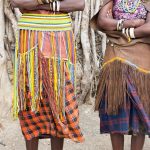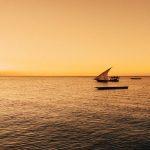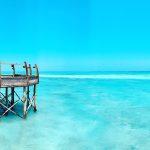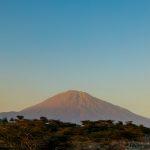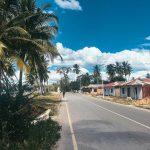300 km south of Dar es Salaam and 105km north of Lindi, Kilwa sits almost halfway along the coast between the capital and the Mozambique border, accessible by some of the worst and even seasonally impassable roads imaginable. As a result, the historic town of Kilwa has become notoriously hard to visit, and something like a sleeping beauty in her castle surrounded by a forest of thorns. Yet it is a region of extraordinary historical interest with abundant archaeological ruins and remains that chart coastal Swahili culture over 1000 years, and as such is listed by UNESCO as a world heritage site.
Kilwa Kisiwani Facts
The strange history of Kilwa has led to its evolving into three distinct areas, distinguishable as the ancient island settlement, Kilwa Kisiwani, ‘of the island’, the old colonial town called Kilwa Kivinje, ‘of the casuarina trees’, its central and modern port town known as Kilwa Masoko, ‘of the market’. The latter functions as the present-day district headquarters and although lacking intrinsic historical interest of its own, the central position and proximity to the airport make Masoko the best base for accommodation while visiting the surrounding area, with the added benefit of being in easy reach of good beaches.
The most ancient and so historically important of all of these is Kilwa Kisiwani. This was the original Kilwa settlement, dating from as early as 800AD, and it is relevant that remains of some original structures, particularly mosques, predate the first Arab settlement and indicate a Muslim Swahili culture existing as a result of influential trade links. Most archaeological research was discovered by Neil Chittick in the 1960s. An excellent exhibition of the discoveries from Kilwa is on display at the National Museum in Dar es Salaam and is well worth visiting before seeing the ruins to understand the extent of lavish cosmopolitan luxuries that were once prevalent among these ancient stones.
Kilwa means ‘fishing place’, and the island settlement grew from a small fishing village into a flourishing and world-renowned port town, perfectly situated to handle a boom in global Indian Ocean trade. Just north of Sofala and south of Zanzibar, Kilwa became a key port for the import of textiles, china and all the goods brought in through the Arabian gulf, and for the export of African slaves and, most sought after, gold. The resultant prosperity inspired some of the grandest buildings in pre-colonial equatorial Africa and sparked a wrangle for power and control that eventually proved the downfall of a now legendary civilisation.
The ruins at Kilwa show a recurring pattern of rising and falling fortunes that were endemic to coastal trading and dependant on global demands for gold, but eventually, the ancient city lost prominence and fell into disrepair. These days a population of around 600 inhabits Kilwa ‘on the island’, and the ruins are skirted by a neat rural East African village copiously surrounded by small stick fences to keep rampaging warthogs from the vegetable gardens. And yet you may still come across one or two extraordinary-looking families with pale skin and strangely pale eyes whose names and features indicate their connection with the original Shirazi settlers.
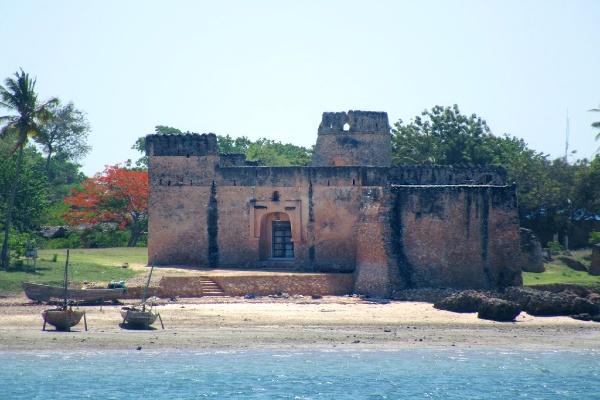
David Stanley – Flickr. Gereza Kilwa Fort.
Legend of Kilwa Kisiwani
Legend tells that in the late 12th century the island was bought for a length of cloth by a self-proclaimed Persian (Shirazi) sultan named Ali bin al-Hasan. Four hundred years later it was recorded that he provided enough material to stretch all around the island. This is possibly an exaggeration as it would require nearly fifteen miles of cloth. During his reign, the wealthy sultan issued a vast number of copper coins in his name, and these continue to be unearthed by grubby-handed children with a precocious eye for tourist dollars clutching well-worn handfuls or slivers of these relics. Sultan Ali bin Al-Hasan’s family ruled for 3 generations, but finally had the power wrested from them in 1300 by the established and powerful Mahdali family.
Kilwa experienced a surge in wealth and prominence from trade and shipping when gold demands were at their peak in the early 14th century and this is reflected in the number of stone buildings that were built at this time. In 1320 the Great Mosque was enlarged to four times its size, and domes were added to the Mosque and the historic Husuni Kubwa palace. A profusion of townhouses was built in the town centre from quarried coral and lime, although this style remained the preserve of the wealthy and clay, wood and thatch homes continued to be constructed around the outskirts.
These stone houses were designed in a regular, measured, but less grand style with flat roofs on wooden rafters supported by pillars. There is now little evidence of these original buildings on Kisiwani since many of the older domestic buildings were robbed for stone during a successive phase of affluence during the 18th century, although the ruins on the nearby island of Songo Mnara still show this early style. Thankfully the mosques escaped this demise, as even their stones are considered sacred.
Kilwa developed importance as a mid-point port between Zanzibar and the gold and slave-trading port of Sofala at the mouth of the Zambezi in present-day Mozambique. The town would have been a key point of trade for timber and ivory, gold and slaves brought along well-worn caravan routes from the interior and exchanged for goods to and from South Arabia, Persia and India. The wealthy merchant inhabitants certainly lived in a grand style, with opulent lifestyles reflecting their worldly connections. Descriptions of the island in its heyday, while the Shirazi Arabs were controlling the gold trade from Sofala give an evocative impression of its charms.
A fourteenth-century report by Ibn Battuta, a devout, wealthy and educated Muslim with a reputation for travelling that named him ‘the [sheikh] traveller of the age’, described Kilwa when he saw it first in 1331as being ‘amongst the most beautiful of cities, and elegantly built…’. Ibn Battuta held the status of a qadi, judge of Islamic shar’ia law and was invited to visit Kilwa by the Sultan, al-Hasan ibn Sulayman, who had himself spent two years in Mecca. At this time, the Sultan also would have held dominion over the grand developments on the nearby island of Songo Mnara.
This beautifully organised settlement at the centre of the gold route so impressed the Portuguese that over a century and a half later they forcefully wrested control and claimed the power of the island for themselves. It was not taken without a struggle, and when the fleet commanded by Pedro Alvares Cabral arrived in the early 1500s they were greeted with such suspicion by Sultan Ibrahim of Kilwa that there was a standoff at sea for two days, with neither agreeing to go to the other. Finally, the fleet gave up and sailed away from Kilwa, who had refused their demands for a Portuguese trading port under Christian dominion. But they had not failed to notice the elegance of the island port, with its vast palace and courtyards, fountains, orchards and mosques.
Vasco de Gama returned to take a much stronger line with the Sultan, offering to bombard the town entirely to dust unless the Sultan bowed to the Portuguese occupation and paid them an annual tribute in gold. Their desire to overthrow this irritatingly resistant stronghold and thus control the flow of all of the gold should not be underestimated, and finally, they attacked, looting and plundering the town, which the Sultan had deserted in the night. Finally, the Portuguese flag was raised in Kilwa.
With little regard for their own input, the new dominion was even more eloquent about their inherited stronghold, and in 1503 Dom Francisco d’Almeida wrote, ‘Kilwa, of all the places I know in the world, has the best port and the fairest land that can be…In it are lions, deer, antelopes, partridges, quail and nightingales and many kinds of birds and sweet oranges and pomegranates, lemons, green vegetables, figs of the land, coconuts and yams and marvellous meats and fishes and very good water from the wells.’ Unfortunately, the Portuguese were subsequently responsible for the most devastating decline of this ‘fairest land’, as the dispossessed Arabs then had no fortune to maintain the town and it fell into disrepair.
Just ten years after Dom Francisco’s proclamation, the Portuguese abandoned their blissful island home and centred their control on the more manageable islands further north. Kilwa’s luck was not yet to improve, as shortly after this time, in the late 1500s, the island was subjected to a surprise attack by the Zimba tribe from Zimbabwe, who are reported to have arrived and eaten a large proportion of Kilwa’s inhabitants.
Later Omani Arabs took over Kilwa at the beginning of the 1700s, but Kilwa regained its independence in 1770. Trade saw a brief revival in the 18th century, as international commercial trends dictated an increased demand for ivory and slaves, and again Kilwa experienced a knock-on surge of building. The mosques were renovated, and a new and fortified palace was constructed. So big and so impressive in fact, that it was known as Makutani, The Big Walls. This phase of prosperity was sadly shortlived, as in 1784 the Omani Arabs loomed back into prominence and once again wrested political control with true conquering verve the Omanis claimed jurisdiction by building over the Portuguese foundations
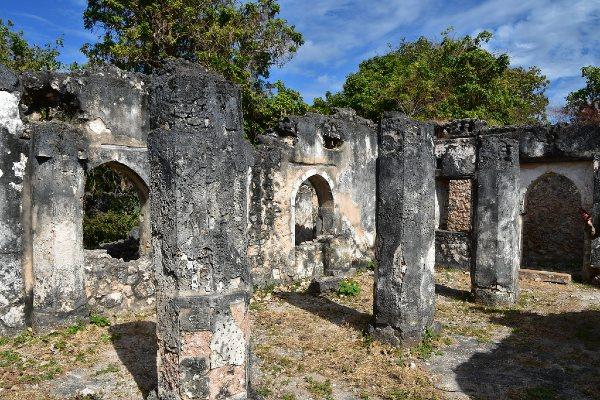
Richard Mortel – Flickr. Malindi Mosque on Kilwa Kisiwani.
How to Visit Kilwa Kisiwani
Visitors to Kisiwani tend to arrive on the shore beneath an impressive ancient fortress generally called the Gereza. This monumental stone edifice is a typical coastal fortress, added to by successive generations of empowered governments. The Portuguese originally constructed the fort, reportedly in less than three weeks. They were evidently satisfied by their efforts, judging from the proud report from Francisco d’Almeida to the King of Portugal in 1505, offering ‘years of [my] life for the King to see…it is so strong that the King of France could be awaited there and has lodgings in very fine houses for twice as many people as are left there now.’
The structure as it is today is mainly the handiwork of the Omani Arabs who built over the old Portuguese remains when they took over Kilwa in the 18th century. When explorer John Speke visited in 1857 he recorded that the inscription above the door was still legible showing that the gate was in built in 1807, sometime after the Arabs had regained control. Today the rooms in the northeast corner are in the best condition, although the entrance hall with its stone benches and arrow slits provides an eerie sense of the building’s original function. Musket bullets and beads have been found in the preserved rooms, and two German canons remain rusting in the central court.
Now the only battle the Gereza faces is the continual encroachment of natural forces. Wind and sea have eaten into its once-powerful stone substance, its courtyards are turning to grass and high on its tower a baobab has taken root.
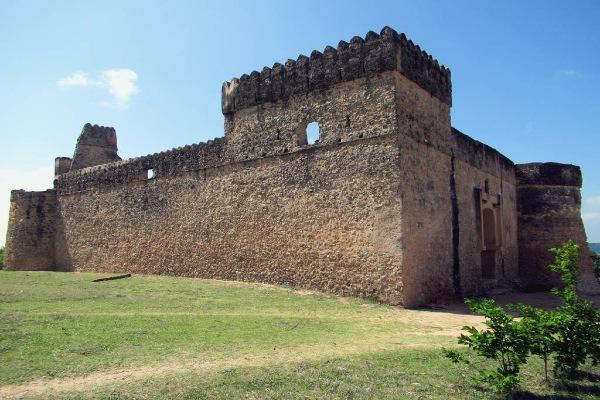
David Stanley – Flickr. Gereza Kilwa Fort.
What to Do in Kilwa Kisiwani
A short walk brings you to the monumental and remarkably well-preserved remains of The Great or Friday Mosque. When the Great Mosque was built in the eleventh century it would have been a small typical Swahili coastal design with a flat roof, supported on nine sixteen-sided wooden columns in rows of three. This is now the open-air northern portion of the standing mosque, and the remains of the original open-air washing area are evident on the western side, with a small sunken courtyard and sandstone blocks for rubbing the feet dry after washing.
The growing demand for gold in India and Europe and the resultant prosperity of the port three centuries later in 1320 saw the mosque dramatically enlarged to reflect the increased status of the town, and crowned with its charismatic domes. These would have been influenced by the growing awareness of international architectural styles practised on the opposite shores of the Indian Ocean, and the finished design became the glory of the coast. Unfortunately, the elegant eight-sided pillars were not strong enough to support an ambitiously large dome on the southeast corner, and after the roof began to crumble these were reconstructed with slightly less refined coral limestone blocks.
Neil Chittick’s excavations in the 1960s revealed the foundations of ‘The Great House’ behind the Great Mosque. An interesting link between all of the important buildings on Kilwa is the intricate underground passage system, which was probably used to carry water between the Gereza, mosque and palace which extends to 12m deep in places.
Nearby is The Small Domed Mosque, a miniature reproduction of the Great Mosque. This tiny ruin has a fascinating and unusual charm, with a neat symmetrical nine-domed square flanked by a tiny washing room. The ceiling inside is carved with small roundels that were once filled with colourful eastern ceramics, still evident in some areas, and the roof is crowned with an impressive stone obelisk although the top portion has broken off. The small mosque was based on the remains of a much older building and would have originally been elevated on a platform above the level of the street. To the south and southeast of the central mosques are three cemetery areas, one of which is said to contain the tombs of the Kilwa Sultans, and another is known as the ‘graves of the forty sheikhs’; apparently the result of a protracted argument that resulted in all forty of them dying on the same day.
Beyond the mosque at the western end of town are the remains of a lofty construction known as Makutani, ‘The Place of the Great Walls’, thought to have been a residential palace for the sultans in the late 17th and 18th centuries. The western aspect is designed as a network of grand reception rooms, courtyards and kitchens, and long stone tunnels from floor to floor that would have served as an early and elaborate form of indoor pit latrine, and cause great consternation among most of the guides that show you around.
But a mile from the centre of town stands lasting evidence of a far more opulent and elaborate culture of sultan rule that predates the Makutani settlement by at least three hundred years. At the height of Kilwa Kisiwani’s wealth and prestige an exceptionally grand and fascinating Palace, the Husuni Kubwa, was built a mile from the town centre on the island coast. The palace is a fine architectural spread of open and arched courtyards, three-storey elevations of rooms and an elaborate octagonal bathing pool that shows a style and expertise quite unlike anything else on the Zanj coast at this time. This fantastic stronghold was positioned to command views over Kilwa harbour and benefit from the coastal breeze.
Visitors generally first enter the palace through the Domestic Court, climbing a series of worn stone steps that reach a high platform at the end of a long courtyard with open porticoes to either side. The next-door room on the West side is the Pavilion, where the sultan would carry out his public office, commanding views of the coast from a pleasantly cool and shady arena. To the West again is the Audience Court, where the Sultan would also have received his visitors. The lower half of the coral wall is carved with small square niches, which are thought to have perhaps contained flickering gas lamps or were otherwise just for decoration. This area is likely to have been used for entertainment such as dance performances, with audiences seated on the steep flight of steps at the Eastern end. A foot tank is built into the stairs at the entrance to the Pavilion so that all visitors attending the sultan could be certain to come with fragrant feet.
The strangest thing about Husuni Kubwa is the knowledge that the palace was only occupied for three generations, at most. The exceptional opulence of a palace so grand could not sustain its own momentum. Even filling the pretty little octagonal swimming pool would have required scores of slaves hand-carrying water buckets enough to fill its 17,500 gallons (80 cubic metres) capacity. The sheer enormity of the manpower required, slaves or servants, and the logistics required to run the beautiful palace on the cliff top were just incompatible with any change of fortune, and now the ruins represent the mesmerising peak of power, grasped and then lost forever.
Kilwa Kivinje
Kivinje developed as a prosperous mainland port town during the reign of Sultan Seyyid and then continued to feature as an important trading post for the German colonialists. Most buildings were built in the early to mid 19th century and some German buildings were in the late 19th Century.
The stone buildings along the waterfront are from the German colonial period, notably a boma, customs post, and 2 large houses on Mjengera Road. Also off Mjengera Road is an old Islamic building complex, a walled open space containing a house, a small mosque, ‘bikira’ (washing facilities) and a cemetery.
It has been noted that there are surprisingly few mosques in the old quarter of town. A rumour persists that the German District Officer complained bitterly about the noise of the daily hazzan, the Muslim call to prayers close to his residence. This brought about a swift construction of a new Friday mosque outside the old town centre and forced the abandonment of the old.
The German monument of 1888, flanked by four up-ended canons, is now mostly submerged by drifting sand piles
Kivinje operated as a clandestine slave trading port until the late 1880s, until a British initiative in 1884 placed their vice-consuls at the three major ports along the coast to monitor and quash the last vestiges of the trade.
In 1956 the District HQ was transferred from Kivinje to Masoko which had a deeper harbour and was closer to the airport strip.
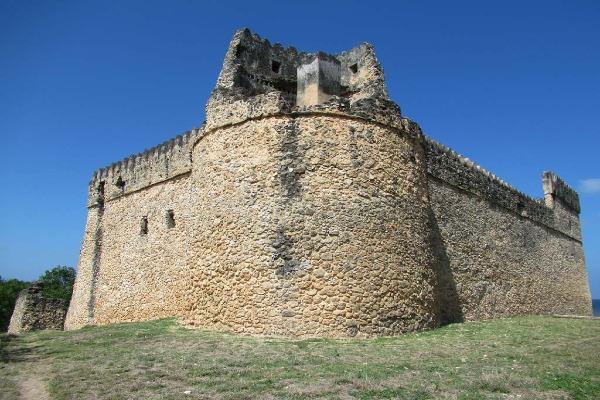
David Stanley – Flickr. Gereza Kilwa Fort.
Kilwa Masoko
The new main town of Kilwa Masoko sits astride the main coastal road with an air of sun-baked sleepiness and wild-west quiet throughout the daylight hours. It comes alive when night falls, and a large market gathers in the sandy streets parallel to the beach. The streets are then illuminated with small fires cooking fish and maize, and crackling sound systems crank into action from the surrounding collection of small bars and restaurants.
During the day, the beach is pleasant to walk, with some more secluded areas for swimming, although it is a rural area and it is worth keeping any valuables safe.
Where to stay in Kilwa
Masoko is the best place for accommodation in Kilwa, and although there are no upmarket choices, The New Mjaka Guesthouse on the main road provides decent enough rooms with en-suite bathrooms and even a ‘sitting room’ in detached bungalow bandas. These are blessed with running water, fans, nets and electricity and are kept clean and hospitable. The establishment is family-run and meals tend to be limited to whatever is available that night. There is little English spoken in Kilwa, and it is worth keeping a phrase-book handy for all kinds of negotiations. If you are having communication problems at Mjaka it might be worth asking if Dula is around. Rooms are available for around $10. There is a pleasant atmosphere next door in the Masoko by Night Bar, or across the street at the Memory Bar.
The Masoko Hilton Hotel is also good, with clean and well-kept accommodation for Tsh3000 for a self-contained double. This friendly little guesthouse is closer to the beach near Masoko Primary School. The next-door restaurant is also immaculately kept and a good choice for wholesome and inexpensive plates of local cooking.
Edit: Brand new Fanjove Private Island is an incredible beach lodge just off the coast of Kilwa.

